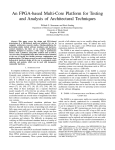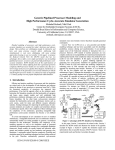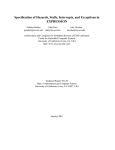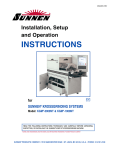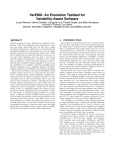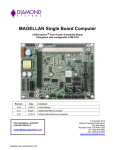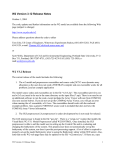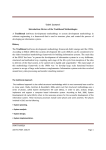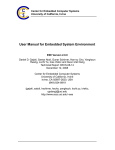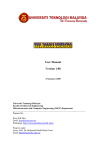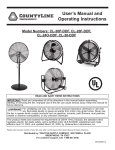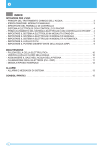Download Tutorial for the SPARK Parallelizing High
Transcript
Tutorial for the SPARK Parallelizing High-Level Synthesis Framework Version 1.1 Sumit Gupta Center for Embedded Computer Systems University of California at San Diego and Irvine [email protected] http://mesl.ucsd.edu/spark c 2003-2004 The Regents of the University of California. Copyright All Rights Reserved. April 14, 2004 Contents 1 2 About this Tutorial 2 1.1 Reporting Bugs . . . . . . . . . . . . . . . . . . . . . . . . . . . . . . . . . . . . . . . . . . . . 2 1.2 Acknowledgments . . . . . . . . . . . . . . . . . . . . . . . . . . . . . . . . . . . . . . . . . . 2 1.3 Change Log . . . . . . . . . . . . . . . . . . . . . . . . . . . . . . . . . . . . . . . . . . . . . . 2 1.4 Copyright . . . . . . . . . . . . . . . . . . . . . . . . . . . . . . . . . . . . . . . . . . . . . . . 3 1.5 Disclaimer . . . . . . . . . . . . . . . . . . . . . . . . . . . . . . . . . . . . . . . . . . . . . . . 3 Downloading and Executing the Spark Tutorial 4 2.1 Downloading and Setting up the Tutorial . . . . . . . . . . . . . . . . . . . . . . . . . . . . . . . 4 2.2 Synthesizing the Motion Compensation Algorithm . . . . . . . . . . . . . . . . . . . . . . . . . 5 2.3 Functional Verification of Output C Generated by Spark . . . . . . . . . . . . . . . . . . . . . . . 7 2.4 Viewing the Graphical Output of Spark . . . . . . . . . . . . . . . . . . . . . . . . . . . . . . . 8 2.5 Logic Synthesis of VHDL Output of Spark . . . . . . . . . . . . . . . . . . . . . . . . . . . . . 8 2.6 Logic Synthesis using non-Synopsys Logic Synthesis Tools . . . . . . . . . . . . . . . . . . . . . 9 1 Chapter 1 About this Tutorial This tutorial demonstrates how to use the Spark parallelizing high-level synthesis software tool with an example. Through the tutorial, you will learn how to invoke Spark, how to sometimes modify C code to make it synthesizable by Spark. 1.1 Reporting Bugs The Spark distribution comes with no official bug fixing support or maintenance and we are not obliged to provide any updates or modifications. However, you may report bugs to: [email protected] Subject: BUG: Brief description of bug 1.2 Acknowledgments The Spark framework was developed by Sumit Gupta with major contributions to the underlying framework by Nick Savoiu. Mehrdad Reshadi and Sunwoo Kim also contributed to the code base. Professors Rajesh Gupta, Nikil Dutt and Alex Nicolau led the Spark project. This project was funded by Semiconductor Research Corporation and Intel Incorporated. 1.3 Change Log Date Changes 1/12/04 Introduced documentation for the newly introduced Windows version of SPARK. Also, some additional notes in the VHDL section since output VHDL is now synthesizable by Xilinx XST 09/1/03 First release of document 2 1.4 Copyright c The Spark software is Copyright 2003-2004 The Regents of the University of California. All Rights Reserved. Permission to use, copy, modify, and distribute this software and its documentation for educational, research and non-profit purposes, without fee, and without a written agreement is hereby granted, provided that the above copyright notice, this paragraph and the following three paragraphs appear in all copies. Permission to incorporate this software into commercial products or for use in a commercial setting may be obtained by contacting: Technology Transfer Office 9500 Gilman Drive, Mail Code 0910 University of California La Jolla, CA 92093-0910 (858) 534-5815 [email protected] 1.5 Disclaimer ❐ The Spark software program and the documentation is copyrighted by the Regents of the University of California. The following terms apply to all files associated with the software unless explicitly disclaimed in individual files. ❐ The software program and documentation are supplied ”as is”, without any accompanying services from The Regents. The Regents does not warrant that the operation of the program will be uninterrupted or errorfree. The end-user understands that the program was developed for research purposes and is advised not to rely exclusively on the program for any reason. ❐ In no event shall the University of California be liable to any party for direct, indirect, special, incidental, or consequential damages, including lost profits, arising out of the use of this software and its documentation, even if the University of California has been advised of the possibility of such damage. The University of California specifically disclaims any warranties, including, but not limited to, the implied warranties of merchantability and fitness for a particular purpose. the software provided hereunder is on an ”as is” basis, and the University of California has no obligations to provide maintenance, support, updates, enhancements, or modifications. 3 Chapter 2 Downloading and Executing the Spark Tutorial In this chapter, we explain how to download, setup and execute the tutorial. The sample design we have used for this tutorial is the Berkeley MPEG Player [1]. The MPEG player is representative of the class of multimedia and image processing applications that the Spark parallelizing high-level synthesis framework has been developed for. In this tutorial, we show how “C” code downloaded from the Internet can be synthesized using Spark and the resulting VHDL can be synthesized using commercial logic synthesis tools. 2.1 Downloading and Setting up the Tutorial The tutorial is part of the Spark distribution that can be found at the Spark website [2] at: http://mesl.ucsd.edu/spark Choose the appropriate distribution based on the operating system you want to work on. The distribution will be named “spark-[OS]-[Version].tar.gz”. So let us say you are interested the 1.1 version for the Linux platform, you will download the file “spark-linux-1.1.tar.gz”. For the Windows distribution, we ship a ZIP archive named “spark-win32-[Version].zip”. After downloading this file, gunzip and untar the file as follows: gunzip spark-linux-1.1.tar.gz tar xvf spark-linux-1.1.tar.gz OR unzip spark-win32-1.1.zip Uncompressing (gunzip and untar) the distribution will create the following directory structure: spark-[OS]-[Version]/ bin/ include/ tutorial/ spark-setup.csh spark-setup.sh 4 where [OS] is the operating system for which you downloaded the distribution and [Version] is the Spark version. To begin with source the “spark-setup.scr” script as follows: source spark-setup.csh # if you are using csh/tcsh shell . spark-setup.sh # if you are using sh/bash shell For the Windows distribution, if you are using Spark under CYGWIN or MSYS/MINGW, then you can source the spark-setup.sh file, else for native Windows, you can run the batch file “spark-setup.bat”. The “spark-setup” script sets up the path to the Spark executable, along with some environment variables and some default include paths required by Spark. The include directory contains standard “C” include files such as stdio.h et cetera that are included by some input applications (including our tutorial). However, note that for the Windows distribution, these include files are not useful. If you do want to include system files such as “stdio.h” et cetera, please specify the path to these files using the environment variable SPARK INCLUDES or using the command-line flag “-I /path/to/include”. The directory “tutorial” contains the Spark tutorial. The contents of this directory are: tutorial/ mpeg_play/ synops/ README.txt README-win32.txt The directory mpeg play contains the Berkeley MPEG player distribution. We will next demonstrate how to synthesize the motion estimation algorithm from this MPEG player. The synops directory contains the Synopsys logic synthesis scripts for synthesizing the output VHDL generated by Spark. We will come back to this in Section 2.5. 2.2 Synthesizing the Motion Compensation Algorithm We choose the Motion Compensation algorithm from the MPEG-1 player for synthesis since this is one of most computationally expensive parts of the decoder. In the Berkeley mpeg play distribution, this algorithm can be found in the file motionvector.c. An overview of synthesis of motion compensation algorithm by Spark is shown in Figure 2.1. In this figure, the motion compensation algorithm corresponds to the motionvector.c file. Before we can synthesize the motionvector.c file using Spark, we have to check if the C code in this file is synthesizable. We find that the motionvector.c file has two functions ComputeForwVector and ComputeBackVector. However, one of the inputs of the ComputeForwVector and ComputeBackVector functions is a structure VidStream∗ the stream. These functions then call the ComputeVector function (declared as a #de f ine) with the relevant members of the struct VidStream ∗ the stream. Since Spark does not currently support structs (see User Manual), we split the motionvector.c file into two files: motionvector callsSpark.c and motionvector f orSpark.c. As the names suggest, the first file calls the second file. We create two functions corresponding to the ComputeForwVector and ComputeBackVector functions in the 5 MPEG−1 Player C Application SPARK Parallelizing High−Level Synthesis Tool Motion Estimation Algorithm C After Scheduling RTL VHDL Functional Verification Logic Synthesis Figure 2.1. Partitioning of the MPEG player application and synthesis of the motion compensation algorithm by the Spark high-level synthesis tool. Spark produces both RTL VHDL and behavioral C as output. The C can be used for functional verification against the input C, and the VHDL can be synthesized using commercial logic synthesis tools. motionvector f orSpark.c file that are synthesizable by Spark. We call these functions ComputeForwVector Modi f ied and ComputeBackVector Modi f ied. These functions take as input the members of the struct VidStream∗the stream that are required by the ComputeVector function. The motionvector callsSpark.c file now contains the original ComputeForwVector and ComputeBackVector functions that now call the modified functions with the appropriate inputs taken from the members of the VidStream ∗ the stream struct. We can now synthesize the motionvector f orSpark.c file by sourcing the script runTut given in the mpeg play directory as follows: source runTut.csh # for csh/tcsh shell . runTut.sh # for sh/bash shell runTut.bat # native Windows batch file This script first checks to see if it can find the Spark binary in the shell path (this check is not done in the Windows distribution; please make sure Spark is in your path). It then runs Spark on the motionvector f orSpark.c file by invoking the following command: spark -m -hli -hcs -hcp -hdc -hs -hcc -hvf -hb -hec motionvector forSpark.c Note that: For the windows distribution, the motionvector f orSpark.c is modified as motionvector f orSpark win32.c This is to remove “#include” of system files such as stdio.h. For the rest of this tutorial, whenever motionvector f orSpark.c is used, it refers to the file motionvector f orSpark win32.c in the Windows distribution. This command does loop-invariant code motion (-hli), common sub-expression elimination (-hcs), copy propagation (-hcp), dead code elimination (-hdc), scheduling (-hs), output C-code generation (-hcc), output RTL VHDL code generation (-hvf), resource binding (-hb), and counts the execution cycles (-hec). 6 Invoking Spark with these command-line flags produces three outputs: (a) graphical outputs corresponding to Hierarchical Task Graphs (HTGs), Control Flow Graphs (CFGs) and Data Flow Graphs(DFG), (b) “C” corresponding to the scheduled design, and (c) VHDL corresponding to the design after scheduling, resource binding and control-synthesis. To schedule, bind, perform control synthesis, and generate output VHDL, Spark reads two other files besides the motionvector f orSpark.c file. These are the de f ault.spark and the Priority.rules files in the mpeg play directory. The de f ault.spark file is a hardware description file that contains information on timing, range of the various data types, and the list of resources allocated to schedule the design (resource library). The Priority.rules file contains the synthesis scripts that control the transformations applied to the design description. Detailed information about these files is given in the Spark user manual. 2.3 Functional Verification of Output C Generated by Spark Besides RTL VHDL, Spark also generates a behavioral C file that corresponds to the transformed and scheduled design. Clearly, this C file does not have any of the timing (clock boundary) and structural information, but it does have the code transformed by the optimizations applied by Spark. Note that: This functional verification is not done by the Windows distribution of Spark. This is because the mpeg play MPEG player uses X11 libraries and include files for executing. It is thus not portable to Windows (as far as we know). Users of the Windows distribution can skip the rest of this section. The runTut.csh/sh does functional verification using the output C code against the input C code by calling three targets from the Makefile of mpeg play. These calls to “make” produce three executables of the mpeg play distribution for the following three motion estimation files: ❐ motionvector.c: Original motion compensation algorithm shipped with the Berkeley mpeg play software. This produces the executable mpeg play-orig. ❐ motionvector f orSpark.c: motion compensation algorithm modified to make it synthesizable by Spark. This produces the executable mpeg play- f orspark. ❐ ./out put/motionvector f orSpark sparkout.c: The C output file for the motion compensation algorithm produced by Spark after scheduling/synthesis. This produces the executable mpeg play-a f terspark. You can now test that the three executables work and produce the same results by playing the MPEG video file smoker.mpg provided with the tutorial. This can be done as follows: mpeg_play-orig smoker.mpg mpeg_play-forspark smoker.mpg mpeg_play-afterspark smoker.mpg In this way, we can do functional verification of the output C generated by Spark with the input C. This gives us some confidence that at least the transformations applied by Spark have not changed the functionality of the application. 7 2.4 Viewing the Graphical Output of Spark Spark produces output graphs for each function in the “C” input file, before and after scheduling. The format that Spark uses for the output graphs is that of AT&Ts Graphviz tool [3]. See the Spark User Manual for more details on the output graphs generated. You can view the graphs for the input and output (scheduled) motionvector f orSpark.c file by running the following commands: dotty output/HTG_motionvector_forSpark_c_ComputeForwVector_Modified.dotty dotty output/HTG_motionvector_forSpark_c_ComputeForwVector_Modified_sched.dotty for the ComputeForwVector function. dotty output/HTG_motionvector_forSpark_c_ComputeBackVector_Modified.dotty dotty output/HTG_motionvector_forSpark_c_ComputeBackVector_Modified_sched.dotty for the ComputeBackVector function. 2.5 Logic Synthesis of VHDL Output of Spark Running Spark on the motion compensation algorithm by sourcing the runTut.csh/sh script also produces an output VHDL file. This VHDL file ./out put/motionvector f orSpark spark rtl.vhd can be synthesized by Synopsys Design Compiler. Change directory to “tutorial/synops”. The contents of the synops directory are as follows: synops/ dbs/ reports/ scripts/ src/ The runTut.csh/sh script copies the VHDL file ./out put/motionvector f orSpark spark rtl.vhd to the src directory here. The scripts directory contains the Synopsys synthesis script motionvector f orSpark spark rtl.scr. This script can be used for Design Compiler as follows: dc_shell -f motionvector_forSpark_spark_rtl.scr > dc_out.log This script synthesizes the VHDL file and stores the generated reports in the synops/reports directory and the generated database files in the synops/dbs directory. We have set the execution time of the multiplier as 2 cycles in the hardware description file distributed with the Spark tutorial. You can alter this cycle time in the de f ault.spark file that is in the mpeg play directory under the section titled [Resources]. More information on the format of the de f ault.spark file is given in the user manual. 8 2.6 Logic Synthesis using non-Synopsys Logic Synthesis Tools For logic synthesis using tools from other vendors, you can instruct Spark to generate VHDL that is not vendor specific as follows: ❐ Set the “PrintSynopsysVHDL” to false in the “[OutputVHDLRules]” section of the default.spark. This removes references to Synopsys libraries and DesignWare functions from the VHDL code. For example, “library Synopsys, DWARE;” is removed. ❐ You will have to explicitly instantiate multi-cycle components such as the multiplier and divider (if any) from the standard cell library of your technology vendor. This has to be done in the architecture description of res MUL and res DIV in the VHDL code. Note that, in this tutorial we use a two cycle multiplier. Also, you will have to write synthesis scripts for your logic synthesis vendor. 9 Bibliography [1] The berkeley mpeg player. http://bmrc.berkeley.edu/frame/research/mpeg/mpeg_play. html. [2] SPARK parallelizing high-level synthesis framework website. http://www.cecs.uci.edu/˜spark. [3] AT&T Research Labs. Graphviz - Open source graph drawing software. http://www.research.att. com/sw/tools/graphviz/. 10














